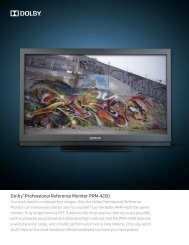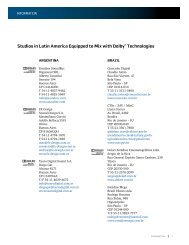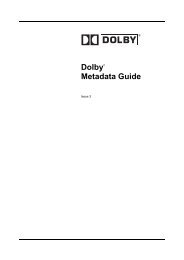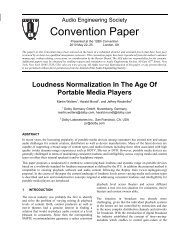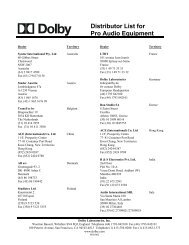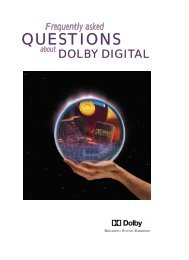Screen Sizes Impact on Picture and Sound - Dolby Laboratories Inc.
Screen Sizes Impact on Picture and Sound - Dolby Laboratories Inc.
Screen Sizes Impact on Picture and Sound - Dolby Laboratories Inc.
You also want an ePaper? Increase the reach of your titles
YUMPU automatically turns print PDFs into web optimized ePapers that Google loves.
worst case, c<strong>on</strong>sider a screen that is illuminated with a picture that is 90 percent<br />
white, with just a small black patch. All the white light bounces off the walls,<br />
<strong>and</strong> depending <strong>on</strong> the surface reflectivity, a certain percentage will bounce back<br />
to the screen. The small black patch will now turn dark gray, <strong>and</strong> the potential<br />
c<strong>on</strong>trast is now much reduced—a reducti<strong>on</strong> to 50:1 is not uncomm<strong>on</strong>. This<br />
much worse number we shall call “limiting c<strong>on</strong>trast.”<br />
What may seem surprising is that limiting c<strong>on</strong>trast is not <strong>on</strong>ly affected by the<br />
surface reflectivity of the walls <strong>and</strong> ceiling, but is also significantly affected by<br />
screen size. The greater the screen size, with a c<strong>on</strong>stant illuminati<strong>on</strong> level, the<br />
smaller the limiting c<strong>on</strong>trast. A simple model can be visualized by c<strong>on</strong>sidering a<br />
sphere, <strong>and</strong> internal visual c<strong>on</strong>diti<strong>on</strong>s varied according to light source areas <strong>and</strong><br />
reflective materials.<br />
First, c<strong>on</strong>sider a sphere which has a uniform internal surface with a reflectivity<br />
of (for the sake of this example) 0.25 or, in subjective terms, dark gray. At some<br />
point in the sphere, a hole is made to allow light in; al<strong>on</strong>gside this<br />
minimal-sized hole, there is a test patch of the same dark gray, of a size<br />
comparable to the light source, certainly a trivial percentage of the total internal<br />
surface of the sphere. A light source outside the sphere is switched <strong>on</strong>, visible<br />
through the small hole. A viewer at the center of the sphere uses a light meter<br />
with a narrow acceptance angle to read the light level at the test patch. With the<br />
minimal amount of light passing through the small hole being reflected from the<br />
gray internal surface back at the test patch, the measured luminance is very low.<br />
Now c<strong>on</strong>sider the case where the small hole to allow light in is exp<strong>and</strong>ed, until<br />
half the internal surface of the sphere is open. In the middle, the same small test<br />
patch remains unchanged. This time, the reflected light from the 25 percent gray<br />
surface has a major impact <strong>on</strong> the luminance measured of the small gray test<br />
patch. In essence, a sec<strong>on</strong>dary light source has been created by reflecti<strong>on</strong> from<br />
the increased total light being reflected from the sphere’s internal surface.<br />
In practical terms, this spherical model translates to a real theatre as follows:<br />
a) As the reflectivity of surfaces facing the screen increases (the<br />
material becomes lighter), the more the screen limiting c<strong>on</strong>trast will be<br />
reduced.<br />
b) As the screen size increases (as a percentage of the total theatre<br />
surface area), <strong>and</strong> with the same c<strong>on</strong>stant spot luminance (for example,<br />
the st<strong>and</strong>ard 16 foot-lamberts), the more the screen limiting c<strong>on</strong>trast will<br />
be reduced.<br />
7




